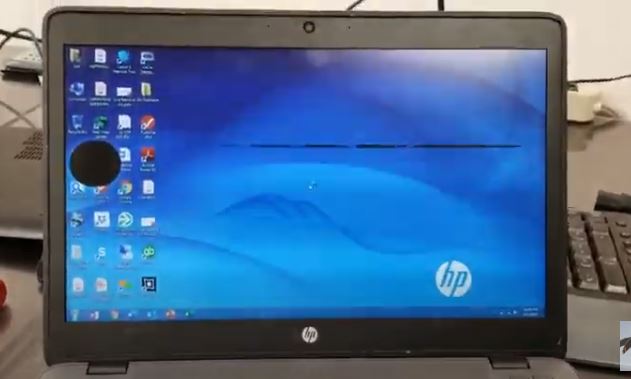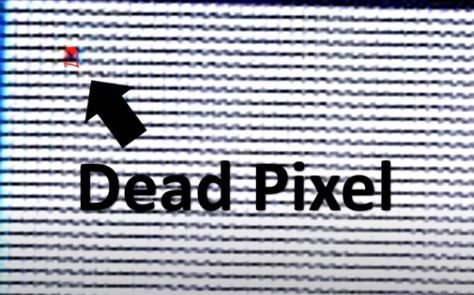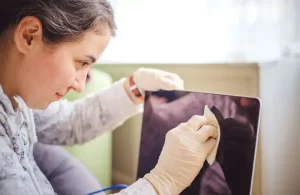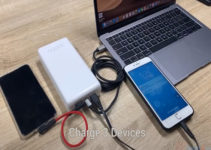How to Fix Black Spot on Laptop Screen: Usually, when people see black spots on their laptop screens, they assume screen damage, just as you did when you initially noticed yours.
However, not all black areas on your laptop’s screen indicate a damaged display. In this article, I will discuss some of the causes and potential cures for black spots on your laptop screen. In addition, you will be given maintenance advice to prevent future instances.

You may now be asking which tricks we are referring to. This essay, however, examines them in depth. So, stay till the conclusion if you wish to learn everything about them
What Causes Black Spots on The Laptop’s Display?
There are a few potential causes for black spots on your laptop screen, but the most common culprit is a trapped or dead pixel. The accumulation of dirt on the LCD surface may also result in black dots on the display. High-temperature exposure and manufacturing faults are additional sources of black spots.
Superficial Dribs and Dirt
The black spots on your laptop’s screen may be the result of superficial dribbles and particles of grime on the device’s exterior. When LCD panels are utilised, dust particles accumulate. When these dust particles are left ignored, they get to form black spots on the screen.
This is a small concern because dust does not collect inside the LCD screen but on its surface. This makes corrections as simple as wiping them off with a moist cloth.
Dead Pixel
Dead pixels are microscopic black spots on the display of your laptop that can cause the image to appear distorted or hazy. In addition, they may cause your laptop to malfunction. Furthermore, Dead pixels and stuck pixels are distinct. A stuck pixel displayed on a screen does not emit light and does not move. A dead pixel produces light, but it does not display the correct image or color.
Stuck Pixel
A stuck pixel black area often appears in the center of the screen and does not move or change color; it forms when a liquid becomes trapped between the pixels and the panel. The fluid can eventually cause the pixels to short out, resulting in a black patch on the screen.
High Temperature
The presence of a cooling system on most laptops is because exposure to high temperatures may be detrimental to the device. When utilised or exposed to extreme temperatures, the computer may encounter latency and hardware problems.
The operation of the processors might also be slowed down. Overheating might also result in the development of black spots on your Liquid Crystal Display (LCD) screen.
Due to the laptop’s screen’s susceptibility to black spots when exposed to high temperatures. If the temperature is too high, the glass may be too fragile to withstand the heat and fracture.
Dry Or Moist Air
Utilizing your laptop under poor conditions is hazardous to the device’s health. One of these is dry or humid air. For example, using a moist towel to clean your monitor can cause temperature issues, resulting in condensation or conductivity.
Therefore, it is crucial to be mindful of the environment in which you use your laptop to minimise faults such as black spots. Avoid as much as possible environments with low humidity.
Physical Damage to the Screen
Physical damage to the screen is another probable cause of black patches on display. It could have been caused by a little scratch on the screen or by dropping the laptop.
Manufacturing Defects
Rarely, manufacturing faults may be the cause of black spots on your screen. In this situation, the only viable option is to replace the faulty gadget with an alternative.
How To Observe Dark Spot-on Laptop Screen
Run the self test designed LCD. The steps are as follows:
- Turn off the display.
- Press and hold the “D” key while pressing the power button to initiate the BIST.
- Multiple colors blinking on the screen; fine lines, distortion, or any other video issues you’ve seen.
Hot to Fix Black Spots on Laptop Screen?
Depending on the circumstances, the specific process for removing the black spot from your laptop’s screen will vary. If only dirt is present, a damp cloth will suffice. However, blocked and dead pixels might be rather obstinate, yet almost every problem has a solution.
Fixing Stuck Pixels
You should not respond immediately when you observe stuck pixels on your laptop’s display. Instead, follow the trapped pixels to see if they disappear. However, if it does not, you may need to consider the second approach.
Using a soft cloth to wipe the damaged area of the screen should remove the sticky Pixel. You may also try restarting your computer to see if it resolves the issue.
Fixing The Dead Pixels

Utilize a gentle microfiber cloth to massage the afflicted pixels lightly. This may correct the issue, but if it does not, you may need to replace the entire screen.
Pressure Method
Using pressure to remedy pixel defects is an additional approach for repairing black areas on a laptop screen. Using a soft cloth and a pen or pencil with a rounded end is accomplished.
Fold the cloth, place it over your laptop’s screen, then apply pressure with a pen or pencil with a rounded end in order to repair your screen using the “Pressure Method.” Perform these steps until the defective pixel returns to normal, if ever. Avoid applying excessive force on your laptop’s screen.
Tapping Method
The tapping approach can also be used to fix damaged pixels on display. For this technique, you will also need an instrument with a rounded tip, such as an eraser or a pen. However, you will not need a soft cloth this time.
Using a wallpaper effect or a blanker, display a screen with a completely black background. Tap the afflicted area of the screen directly with the eraser or pen. When you tap the screen with sufficient force, you should observe a white glow.
Check if the issue has been resolved by reverting the wallpaper to a white background.
Tips To Avoid Black Spots on Laptop Screen
Prevention is better than cure. Nobody wants to get black spots on their laptop in the first place. If you don’t already have one, here are some professional suggestions for preventing black spots on your laptop screen.
Healthy Cleaning Habit

Utilize a soft, moist microfiber cloth when cleaning your PC. Avoid abrasive fibers and cleaning products, including acetone, ammonia, or alcohol. All of these powerful liquids could potentially damage your LCD display.
When contaminants such as ammonia come into contact with a keyboard, the paint may begin to fade. The use of plain water should suffice to remove dust from your laptop.
Work On a Laptop Desk
Using a laptop desk while working on your laptop will dramatically reduce the likelihood of falling, which could cause screen damage.
Stay Away from Direct Sunlight
Additionally, prolonged exposure to direct sunlight can harm your laptop’s display. If you are working outside on your laptop, attempt to restrict its LCD’s exposure to direct sunlight to prevent stuck or dead pixels.
Regulate Temperature
The consequences of exposing a laptop to extreme temperatures are severe. The overheating of the batteries and other internal and external components causes the majority of laptops to malfunction when subjected to temperatures over 35 degrees Celsius.
Maintaining average temperatures when using a laptop for maximum performance is necessary. Obtaining consistent temperatures will also aid in preventing the appearance of black spots on display.
FAQS About How to Fix Black Spot on Laptop Screen
Is there any software to remove black spots on my laptops screen?
Yes, tools such as Dead Pixel Buddy and Screen will assist you in detecting and repairing LCD issues on your laptop. The success rate while employing one of these systems is low, despite their simplicity of use.
How do I get rid of black spots on my laptop screen?
Use a soft microfiber cloth to clean the affected area of your laptop’s screen in order to remove any black smudges. You can also utilise screen repair software to eliminate black dots from your laptop’s display.
Can dead pixels go away?
Dead pixels will not disappear on their own, but you can remove them by following the advice in this article. These methods range from wiping the screen with a microfiber cloth to replacing the screen totally if no answers are apparent.
Can I fix dead pixels?
Although you cannot directly mend a dead pixel, it is possible to resurrect them. You can accomplish this by wiping the area containing the dead pixels with a moist cloth. If you cannot do the task alone, you may always contact a specialist for assistance.
How do i prevent the spread of dead pixels on my laptop?
Locate the dead pixel and label it with a detachable writing instrument, preferably a sticky office note. Next, apply gentle pressure on the pixel with one finger and a wet towel. Turning on your laptop while massaging the dead pixel should clear or prevent it from spreaing.
How to Fix black spot on laptop Screens Dell, HP, or Lenovo?
Regardless of the brand, the methods for removing black spots are identical. The HP pixel correction software is compatible with other models, and the manual pixel correction procedure is compatible with all laptop brands.
How do I remove the black spots on the screen of my HP laptops?
Regardless of the brand, the methods for removing black spots are identical. In addition, the HP pixel correction software is compatible with other models, and the manual pixel correction procedure is compatible with all laptop brands.
How Can I fix a black spot on my LCD tv?
Frequently, it is possible to separate trapped pixels by executing specialised DVD programming to extract pixels from the stopping region. Additionally, the soft fabric of the afflicted area will aid in unbinding the pixel when this software is running.
How do I remove dead pixels from my phone?
Fix mode is activated by tapping the “fix Dead Pixel” button on the home screen. The subsequent screen contains two modes, and clicking the “Start” button immediately initiates the process.
What causes dead pixels on a laptop?
LCD production defects include dead pixels. Even dust on the LCD matrix can produce “dead pixels” due to misalignment or faulty component cutting. LCD panels leaving the manufacturer for laptop installation or resale of parts were typically inspected for defective pixels prior to departure.
Can I do something to prevent the black spots?
You can do little to prevent these spots from occurring, but you can try the following remedies. First, ensure the laptop is adequately cooled. Overheating might result in screen blemishes. Attempt to maintain a clean laptop screen. If the marks result from a dirty display, cleaning it may help.
Why is there a black spot on my laptop’s screen?
There are numerous possible causes for a black area on the laptop screen. A black spot on the screen could be caused by dirt, dust, or debris, but it is harmless. It may also be the result of a dead or trapped pixel. Finally, a black spot in a specific screen area may be due to a trapped pixel.
Can dead pixel spread?
If the dead pixel is on a small screen area, it is unlikely to propagate. If the dead pixel is distributed across a wide portion of the screen, it is more likely to spread.
Final Words About How to Fix Black Spot on Laptop Screen
As you can see, fixing a black spot on your laptop is not difficult, and you may not even need to do so if you maintain your equipment properly. If you know the necessary methods, you can quickly fix stuck or dead pixels.
For the record, LCD black spots are typically caused by dirt or debris on the surface, a pixel, or a dead pixel. Obviously, superficial dirt or debris is the simplest thing to resolve.
In contrast, dead pixels are the most difficult to repair, followed by stuck ones. If a blocked pixel on your LCD causes a black spot, a third-party flashing tool can be used to restore the spot.





